What is Value Communication?
Value-based communication is a best practice utilized by the entire commercial team at leading enterprises. To communicate value effectively, each part of the B2B commercial team plays an important role.
- Product teams quantify the value of your new and existing offerings across targeted customer segments, generating insights on customer outcomes, designing offerings that appeal to address relevant customer needs, and developing value-based prices to capture a fair share of the value delivered. By connecting product features to customer benefits and quantified value, product teams support crisp, customer-centric messages.
- Marketing teams design content and campaigns to communicate the value of your offering to prospects across every buyer channel – website, advertising, email nurture, social media, live and virtual events, and sales enablement collateral. Marketers focused on value communication create a narrative that connects customer challenges to your solution’s quantified outcomes as a buyer’s journey progresses.
- Sales teams engage in sales conversations that communicate the financial benefits of buying your B2B offering in a clear, engaging manner, calling attention to your differentiation as they connect that differentiation to results. Successful value communication invites the customer into a two-way collaboration on a shared business case that highlights the specific outcomes your solution will deliver.

How to Communicate Value to the Customer
Clear and effective value conversations require a shared fluency within your commercial organization – one centered on customer value, and spoken in the customer’s language. Too often, this fluency is fragmented – restricted to senior leadership, limited to subject matter experts, or adopted as a short-term rallying cry before being deprioritized. Without a broadly-shared, continuously supported language of value, B2B organizations struggle to adopt good value communication practices.
There are several key steps an organization can take to foster a culture of consistent, widespread value communication across their entire commercial team:
- Use Direct and Simple Customer-Facing Language: Differentiated offerings typically have a long list of benefits. Product management and marketing professionals are often tempted to make their value propositions complex and unmemorable. To ensure clear communication, quantified value propositions should be simple, direct, and address the most important elements of a customer’s buying decision versus alternatives the customer is considering.
By shifting the focus from technical features to customer outcomes, good value communication invites buyers into a discussion about measured business results. Starting simple, the value proposition can be refined as the customer journey progresses. A few good rules of thumb:
○ Highlight 3-4 points of differentiation. Quantify and communicate what they are worth to the buyer. There is always an option to dig deeper into the data for stakeholders interested in deeper diligence.
○ Make clear, direct comparisons focused on the choice that the customer is considering: your offering versus (1) a competitor, (2) a home grown solution, or (3) the status quo. Buyers are likely to tune out if the value discussion is framed against an option they are not considering.
○ Use customer specific data as it is available – supplied by initial research or by a prospect, in order to make the value proposition relevant. The data don’t have to be perfect, but enabling reps to incorporate customer data into a conversation real time is a difference-maker.
○ Highlight value drivers and measurements that are relevant to different members of a buying committee. Operations professionals might care about costs or price per production unit. Finance professionals may be looking to understand ROI or payback. Members of the C-suite may be more focused on growth opportunities or risk minimization.
- Start With Low Hanging Fruit: Find an important differentiated product and prove out success. Simplicity in value proposition rollout is as important as simplicity of design of initial value content. Organizations that attempt to instill value communication with global mandates of value proposition creation and adoption – whether at the solution, bundle, or deal level – often fail. Instead, an agile, value selling pilot is a great way to initiate value communication in a way that it can be refined, then later scaled.
- Some organizations start with innovative products about to be launched. Quantified value supports pricing, offer design and go-to-market strategy, quickly proving sales enablement content to generate product launch momentum. Starting earlier with a new solution in the R&D stage is another productive approach: as value is quantified as part of a Stage Gate or Agile development process, marketing strategy and messages come into focus based on differentiated value. Early successes can be broadcast internally to support wider adoption of value strategies and value selling.
- Prioritize Fluency in Customer Value at the C-Suite Level: Senior management plays a pivotal role in setting both organizational priorities and organizational tone. The best B2B organizations prioritize customer value as a central operating principle. Senior leadership has ample opportunity to communicate the unique value your organization delivers to your customers. The rest of the team will naturally pick up the torch as senior leaders communicate value clearly and effectively.
- Here are a few ways the C-Suite can set the tone for Value Communication
○ CEO: As the public face of the company, the CEO has a singular opportunity to feature customer value in external and internal communications. When meeting with key customers, shareholders, the press, and analysts, the best CEOs position customer value as a core tenet. When leading internal all-hands meetings and management team meetings, customer value is a great focal point.
○ CFO: As they meet with internal product and marketing leaders, a CFO can ask probing questions regarding customer value such as: “how is this differentiated?” “have you quantified the differentiation?’ “if I were the customer what would be my business case to buy?” and “what pricing is possible to maximize our profitability while supporting a customer’s reason to buy?”
○ CMO: Marketing leaders have a unique responsibility to ensure that customer value is central in marketing campaigns, corporate messaging, enablement content, and public relations/advertising. They play a crucial role in ensuring that product collateral features communicable, measurable value.
○ CRO: Sales leaders are critical in driving adoption of value communication disciplines in sales. Sales leaders should point to value and value selling success in global sales kickoffs. They can drive sales managers to reinforce and review the utilization of value communication in account reviews with reps. They can feature anecdotes of successful value communication by individual team members. They can reward successful sales implementation of value selling. Success communicated from the top generates momentum.
These principles, applied across the global organization, in product, marketing and sales, support broader adoption of value communication. Next, we will explore how each function can support great value communication in greater detail.
Value Communication in Product Development
and Product Management
The foundation for successful value communication begins with B2B product and innovation teams. Developing and managing solutions that deliver differentiated value to the customer is a necessary, but not sufficient, condition for commercial success. This value must also be incorporated in marketing content and campaigns, sales enablement collateral, and sales messaging.
If product teams cannot articulate the value their innovations provide to their customers, how can they expect their marketing and sales teams to do so? How can they expect customers to buy their solution without understanding the value their solution delivers? A strong value proposition, developed in the earliest stages of the product life cycle, is the first step in enabling effective value communication. Value proposition quality has been shown in studies to be both the number one reason why product launches succeed and why they fail.
There are many definitions of a value proposition, but there are three layers to describing value to a customer.
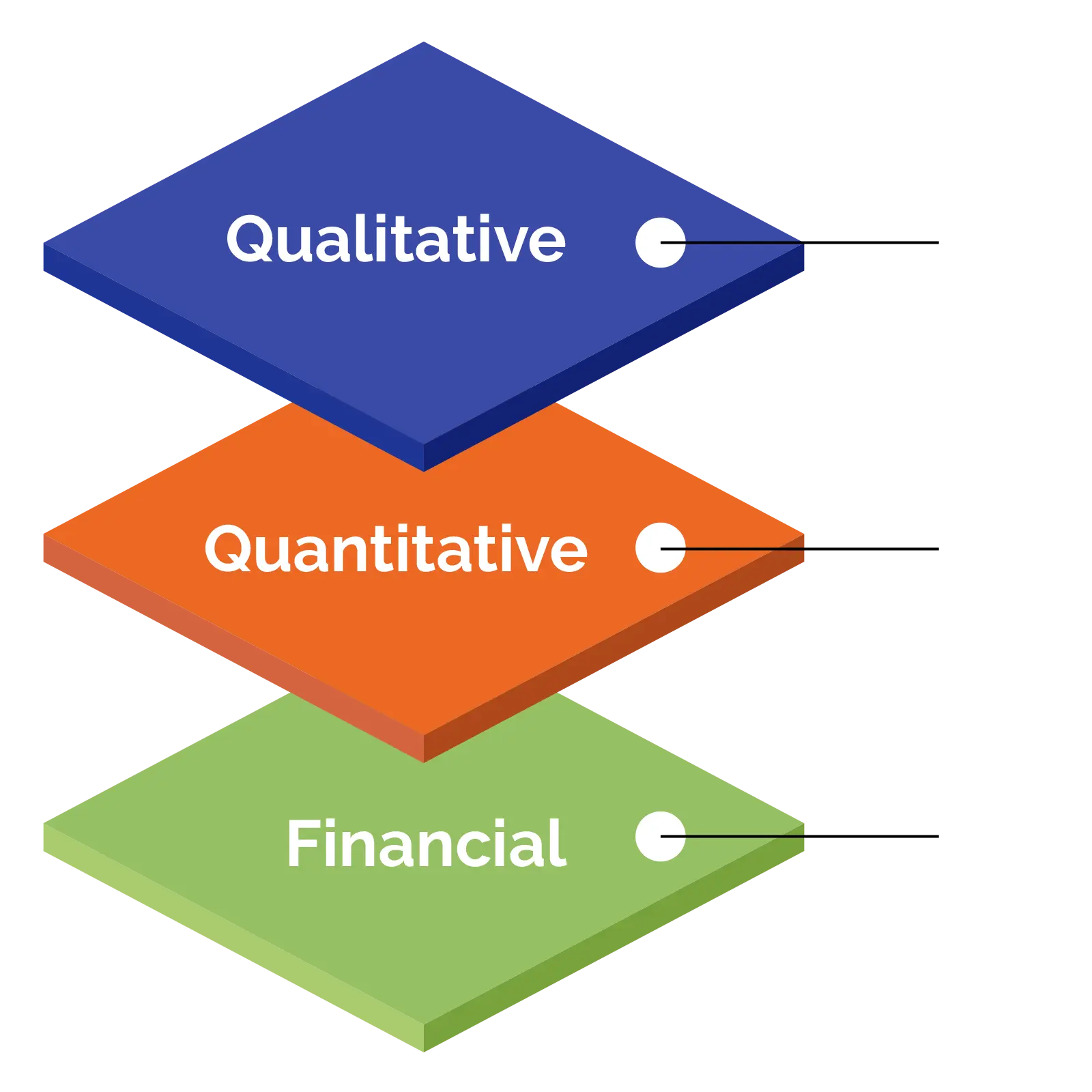
Ex. “Our solution is more energy efficient”
The magnitude impact your solution has on measured customer KPIs / problems
Ex. “Our solution reduces energy consumption by 25% on average”
The specific, financial impact your solution has on your customer’s problems
Ex. “Our solution will save your facility $5m/year on energy costs”
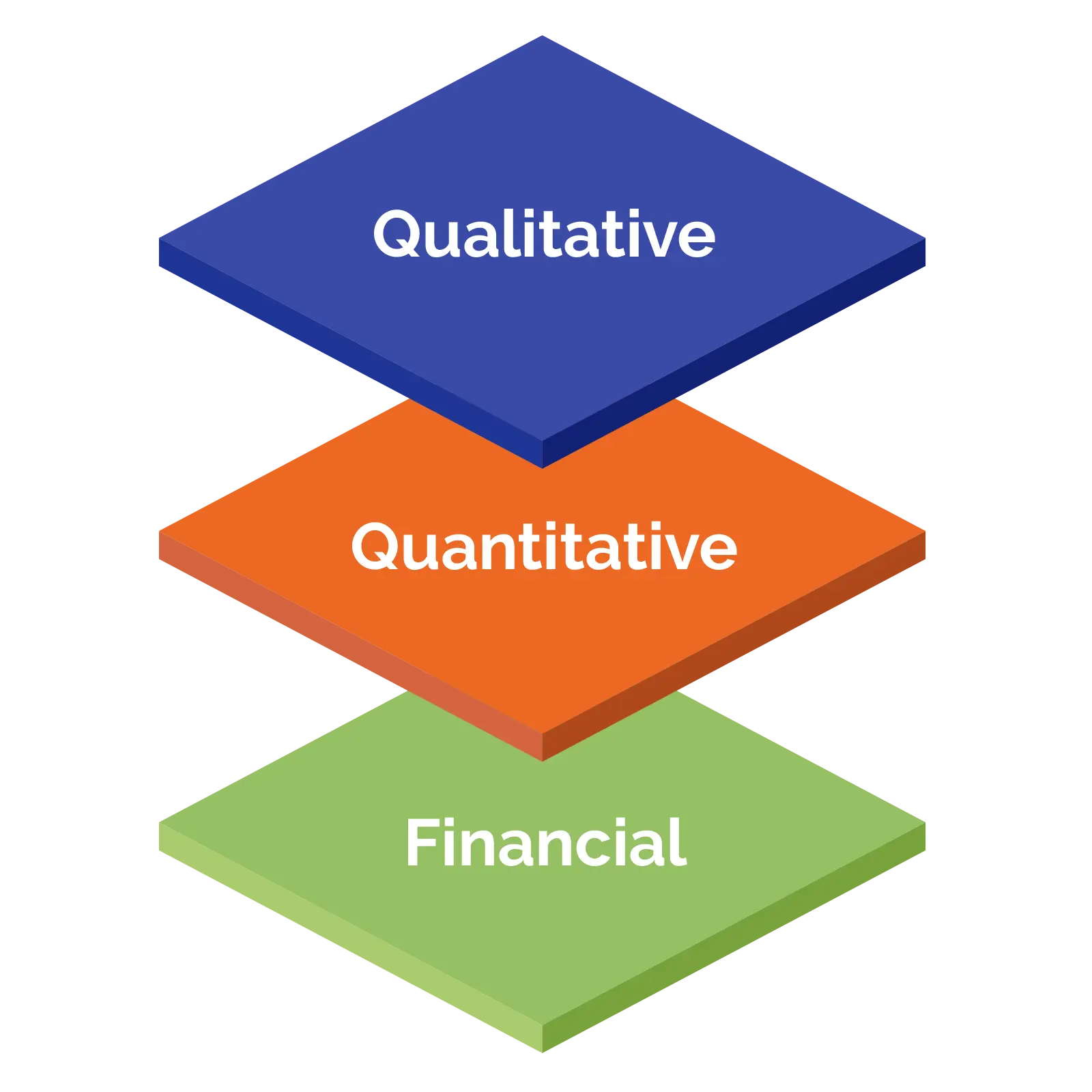
QUALITATIVE
How your solution addresses customer challenges / problems
Ex. “Our solution is more energy efficient”
QUANTITATIVE
The magnitude impact your solution has on measured customer KPIs / problems
Ex. “Our solution reduces energy consumption by 25% on average”
FINANCIAL
The specific, financial impact your solution has on your customer’s problems
Ex. “Our solution will save your facility $5m/year on energy costs”
Product teams should stretch to understand potential customer impacts and product value early, generating hypotheses and initial estimates of quantitative and financial impacts, and refining the value proposition as experience in customer situations generate feedback. Even before they are deployed with customers, quality value propositions support good product decision-making, helping teams to:
- identify target market segments,
- design better offering strategies,
- set value-based prices,
- refine positioning versus the competition (or “do nothing”),
- (and sometimes) pull the plug on non-viable products early.
The exercise of quantifying and dollarizing the financial impact across each of these strategic decisions supports value communication in two main ways. First, embedding value early in the product development process helps product teams ensure that your products in preparation for launch deliver financial value to the customer and make higher new product launch prices defensible.
Second, creating a customer-ready value proposition that is flexible enough to convey the qualitative, quantitative, and financial impact of your offering is a powerful sales and marketing tool that focuses customer interaction on your differentiated value. Value propositions enable organizational alignment around customer value, setting the stage for marketing and sales to communicate the superior outcomes that result from your innovation.
Value Marketing: Content and Campaigns
that Support Value Communication
Modern marketing teams need to engage in an array of different conversations with individual buyers across market segments, geographies, personae and customer journey stages. In many cases, these conversations are happening through channels they can, at best, indirectly influence – such as third party analysts, product review websites, 1×1 product recommendations, and social media conversations.
While there is a lot outside the control of modern marketers, there are more tools than ever to engage customer audiences, educate prospects on the impact that your solution can have on their business, and the specific financial benefits likely to result. Competition is fierce, and value-based marketing can differentiate your solution from the competition.
Value Marketing (or Value-Based Marketing) is the practice of communicating your solutions value across every customer touchpoint. Key to this is understanding that value has multiple layers – which may be introduced differently at the different stages in the customer journey. Value-based marketing strategies serve as the marketing component to broader value communication and value selling initiatives. To understand the impact of value strategies, consider a couple of key concepts
- The Three Layers of Value, which are critical to effective value communication. These layers can be deployed differently for different stakeholders and at different stages of the customer journey.
○ Qualitative: How your solution addresses customer challenges/problems.
■ Example: “Our solution is more energy efficient.”
○ Quantitative: The quantitative impact your solution has on measured customer KPIs/ problems.
■ Example: “Our solution reduces energy consumption by 25% on average.”
○ Financial: The specific, financial impact your solution has on your customer’s business results
■ Example: “Our solution will save your facility $5m/year on energy costs.”
- The Customer Journey Funnel. Dividing the buyer’s journey into stages has long been a popular way for B2B marketers to segment their prospect and customer funnel based on their level of buying intent. The objective of marketing campaigns at each stage is to nurture and convert prospects down to the next stage of the funnel. Viewed through this lens, teams should view value messages as an endpoint of their content strategy at each stage. Reiterating and refining value through the funnel increases sales velocity by transitioning buyers down-funnel faster. By mapping value messages to appropriate customer journey stages, we can often identify gaps in where B2B marketing campaigns miss in communicating value.
- Encourage Value Creation Early and Often: Product managers driving product development make better decisions if they test value hypotheses as part of their Gate Review process. Marketing leaders involved in product launches should require that customer value be quantified as part of launch prep. Product marketing professionals should drive continuous value analyses of existing offerings, using customer value to focus on the most impactful features and identifying changes in the competitive landscape based on changes in perceived and quantified differentiation. Quantified value provides a firm foundation to create value content and messages that resonate with customer audiences.
- Embed Value Messaging at Each Customer Journey Stage: Messaging that clearly communicates value needs to be incorporated into marketing content across all channels is the output. Auditing marketing materials, campaigns and sales collateral for value content is a great way to ensure crisp and clear communication. Consider the following approach:
○ Categorize Content and Channels by Customer Journey Stage: In many cases the appropriate customer journey stage is closely correlated with the asset type. For instance, podcasts and infographics typically live in the engagement stage, while case studies are almost always deployed at the research/justification stage.
Corporate websites tend to span every customer journey stage, so a page-by-page analysis is appropriate. Ideally, messaging frameworks will have been used to develop corporate and solution-level website content, which can be used to relate and translate content to the customer journey stage. Analyzing traffic sources – search terms used to access the page as well as other sources of traffic (email, paid, social, referral) – can also help map value content to the right journey stage.
Finally, messaging embedded within each delivery channel should be analyzed. Email nurture campaigns should be sorted by buyer-stage, social posts should be tailored to the specific audience they are targeting (for example – corporate broadcasts versus communication in product-level user groups), and PPC ads should be relevant to the paid audience being targeted. Opportunities for segmentation and personalization using tailored value propositions should be explored.
○ Embed Content with Stage-Appropriate Value Messaging: As discussed earlier, strong value messaging has three layers – qualitative, quantitative, and financial. For many B2B marketing teams, their engagement content is light on qualitative value or outcomes (even in less-quantifiable terms), their educational content shies away from quantified outcomes, and their research/justification content avoids discussion of financial value delivered. Oftentimes, the financial layer is presented at a stage too late to be effective.
The goal of marketing content at a particular customer journey stage is to convert as many prospects as possible to the next stage fast. Value messaging is an effective way to accomplish this. Calls to action are a great place to weave in value messaging, increasing the velocity with which prospects move through the funnel by painting an increasingly specific vision of value.
○ Identify Opportunities for Segmentation: The more customer-specific the messaging, the better. Your value communication will go further when content is relevant. The proliferation of personalization technology means that website experiences can be tailored to buyer personae in ways that were once unthinkable. Marketing intelligence and buyer intent data can be used to target prospects with the most relevant content and messages across all channels. Interactive value content – such as LeveragePoint Value Campaigns – helps marketing teams initiate the process of building a buyer-specific business case early in the buying process.
- Start Communicating Financial Value Earlier in the Customer Journey: If your sales teams are beginning to build a financial business case in the middle stages of the funnel, they have missed the opportunity to communicate value early. Marketing leaders should utilize content that helps buyers explore the specific financial impact of offerings.
- Historically, ROI calculators have been deployed by marketing and sales as an attempt to facilitate value communications. They have historically taken one of two forms.
○ Interactive Web Calculators: These lightweight tools typically have a few interactive elements, paired with a lead submission form. Marketing technology vendors and consultants have long hoped that these widgets would deliver large volumes of qualified leads, but they often fail to live up to expectations. Only rarely does the information submitted make it into a sales deck, meaning that a business case has to be started from scratch, if it is going to be started at all.
○ Spreadsheet Calculators: Product and presales professionals have long created complex spreadsheets that highlight the financial outcomes associated with the products they develop and sell. Unfortunately, these spreadsheets don’t tell a simple story, are typically usable only by the spreadsheet author, are almost never updated, and fail to serve as an effective communication tool in sales. Spreadsheets are often created for one-off firefighting, not for reuse, and are forgotten very quickly.
Unlike these legacy approaches, an integrated value marketing tool serves as the starting point of a two-way value conversation with your customer. Website visitors in the research stages are able to begin refining their own business case to buy. Once their data is submitted, it is instantly integrated into a value story that provides a presentation platform for the initial sales conversation. These value stories serve as superior tools to support value communication in sales.
Drawbacks of Traditional Value Content
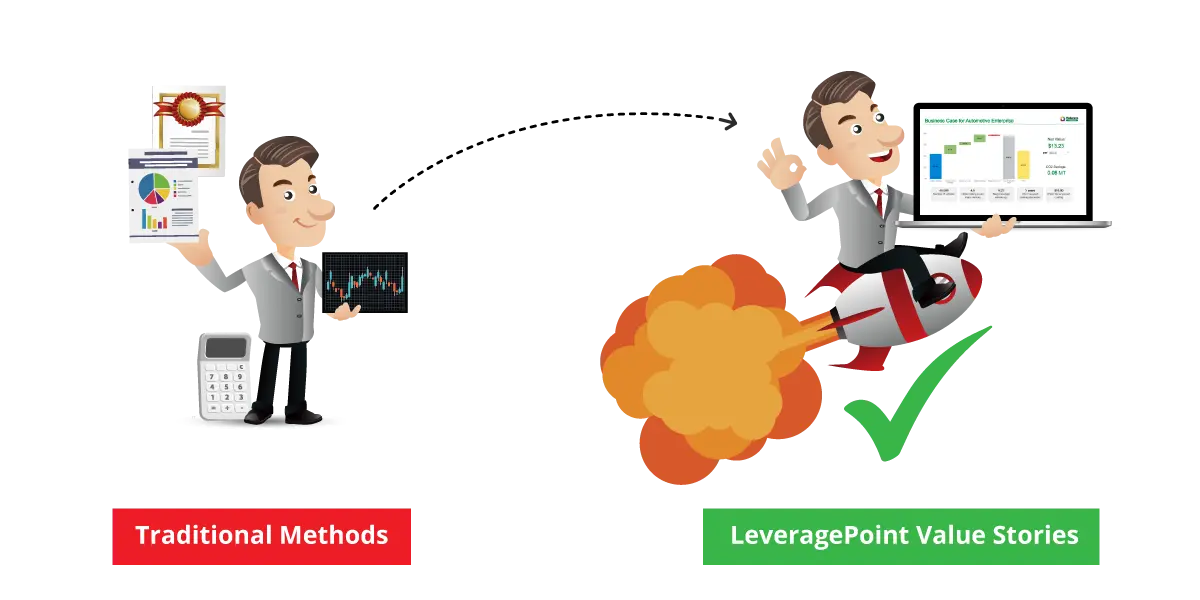
1. Standalone Web Calculators
- Used as a lightweight lead gen tool only – data isn’t utilized or taken seriously
- Fail to help sales generate a plausible business case
- Low credibility with buyers and salespeople.
2. PowerPoint Presentations
- Static, rather than interactive.
- Specific to a single customer that may not be similar to the buyer.
- Underutilized as leave-behind collateral instead of being central to constructing a business case.
3. Case Studies
- Primary vehicle for sales communication can be effective at sharing qualitative messaging
- Static and generic – puts audiences to sleep
- Too feature/benefit focused
- Fail to support two-way value selling conversations, blunting the impact of value content.
4. Spreadsheet Calculators
- Used as a situational sales enablement tool – often too late in the buying process.
- Ugly format does not convey value messages persuasively.
- Bespoke and hard to use/underutilized by sales.
Value Based Conversations: Supporting Effective Sales Communication
Well-designed value propositions directly address these challenges by communicating the differentiated value of the targeted offering. Value stories transform this clear value into an engaging narrative that contextualizes value delivered within an interactive sales presentation.
Great value stories are the best way to support value communication as they provide a narrative that enables B2B sales teams to engage in high-quality value conversations. Selling value is more than a spreadsheet monologue. Sales is as much an art form as a skill, and the manner in which value communication occurs is critical to ensuring that full impact of value selling is realized. Here are the key elements of a great value story
- Narrative: Value proposition content needs to contextualize the qualitative, quantitative, and financial impacts of your solution in a compelling story that communicates a vision of value, appealing to the buyer’s emotions and answering the “why change” question. A chapter-based approach to telling the story makes value messages easier for sales to deliver.
- Customer-Specific: Buyers are risk averse. They need to trust that you have solved problems like theirs for for companies like them. Making your value content specific to the customer’s industry and business makes it resonate with members of the buying committee. Incorporating their own business data into the value content as the opportunity progresses fosters further trust in your business’ ability to execute on the vision of value you are painting.
- Interactive: Great value communication means engaging in two-way, interactive conversations that invite the prospect deeper into a conversation about the problems they face and the results you can deliver. “What-ifs” build trust in the robustness of your offering. Interactive content supports the evolution of initial value estimates to a shared business-case to buy.
- Outcomes-Centric: Focusing sales conversations on the financial outcomes delivered by your solution, rather than features or cost, will help salespeople fast-track deals, shortening sales cycles. A jointly-developed business case focused on value delivered is effective in obtaining decisionmaker signoff, finance approval, and negotiating procurement.
While there are many tools and trainers that promise to deliver the improvements in sales outcomes associated with value selling, B2B buyers should be wary. Value content is wasted if it is not customized for the buyer, sent along as a leave-behind, used sporadically or presented in an uninviting or hard-to-understand format. Effective value communication makes customer results the centerpiece of every sales meeting.
Value Campaigns: Technology to Support Value Communication
Our Value Campaigns help B2B marketing teams generate high quality leads that feed directly into Value Stories for sales use. These interactive presentations help sales paint a vision of value from the first customer call, and collaborate with the buyer on a shared business case to buy. Through LeveragePoint, B2B sales teams have boosted improved win rates 5-15%, achieved 5-25% higher prices, and reduced sales cycle times by up to 75%. Sign up for a demo of LeveragePoint today.
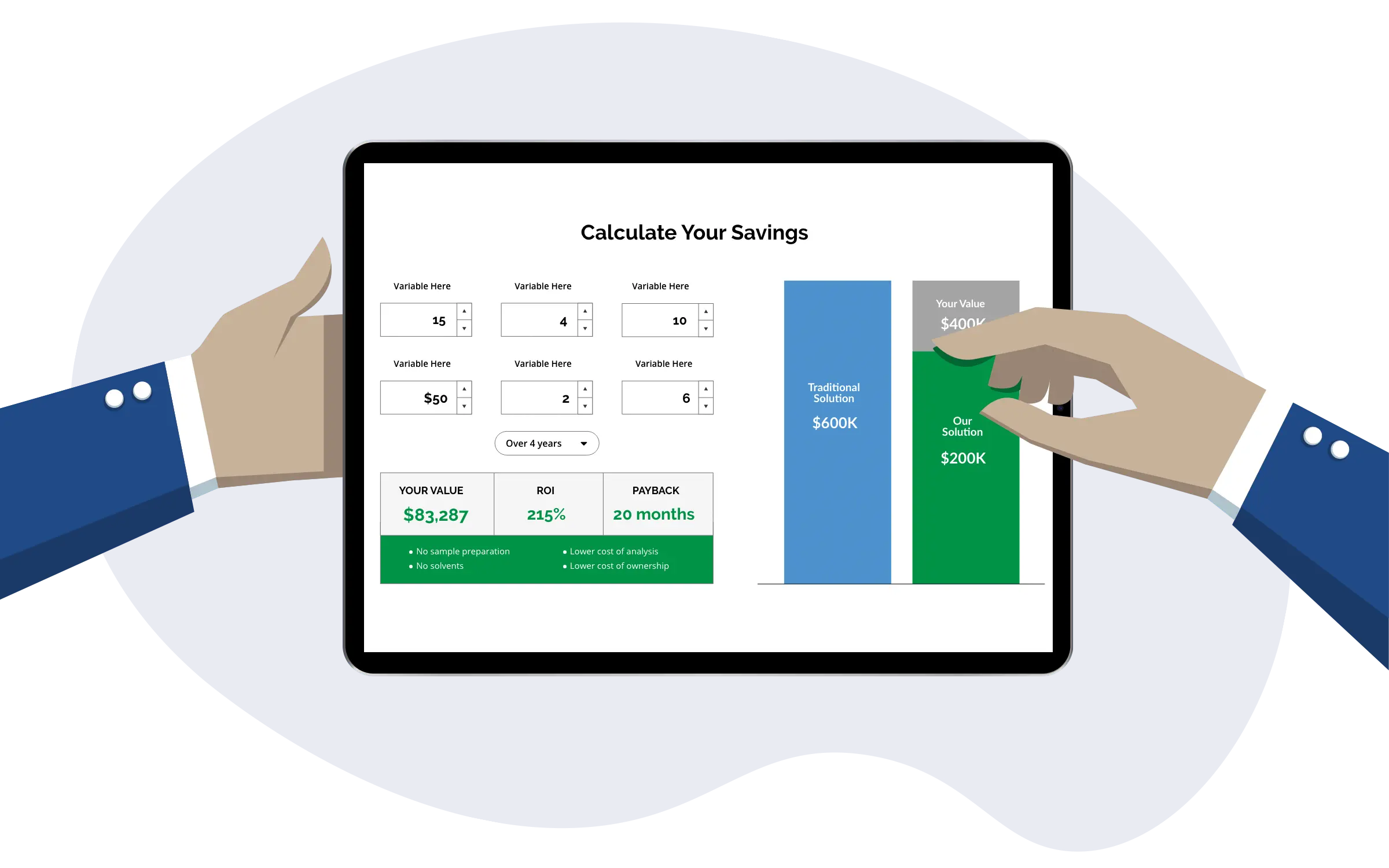
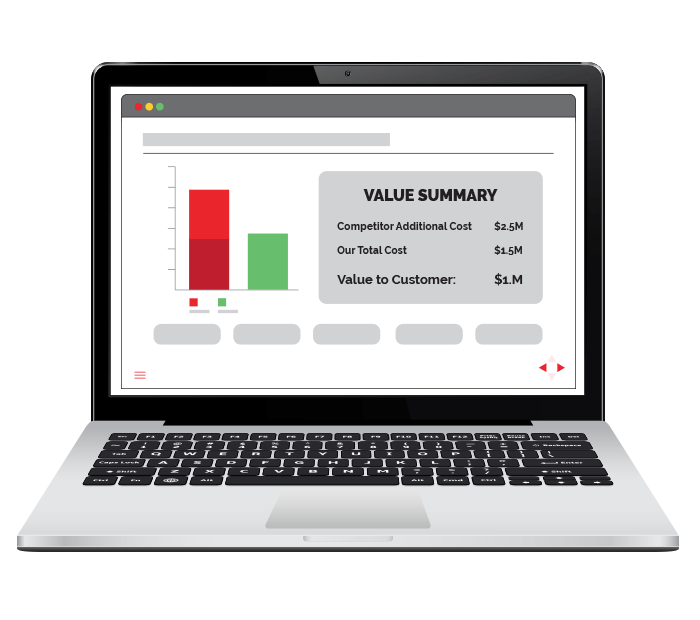
INCREASE YOUR B2B SALES
LeveragePoint is a cloud solution that aligns product, pricing, marketing, sales enablement and sales teams around creating, communicating, and capturing value. Our tool allows these teams to collaborate internally around building a value-based strategy that can be transformed into dynamic value propositions that sales can use to clearly communicate the value of your offering from the very first sales call.

